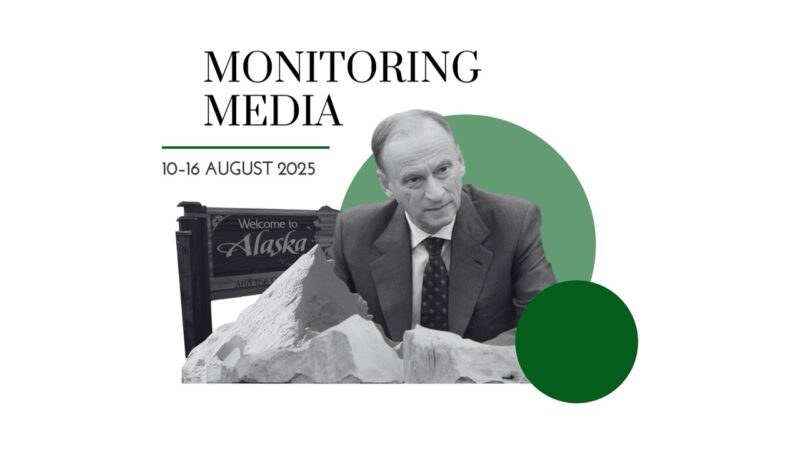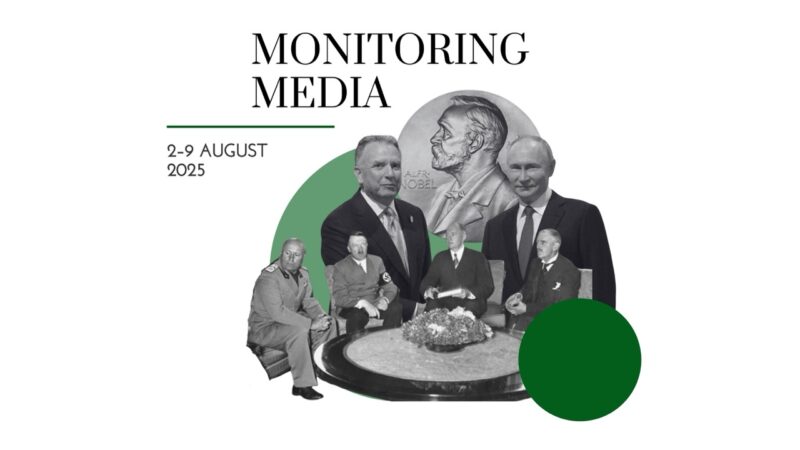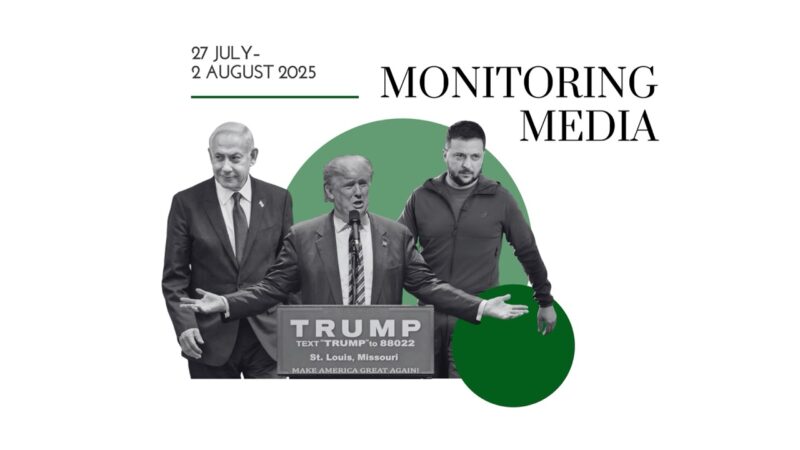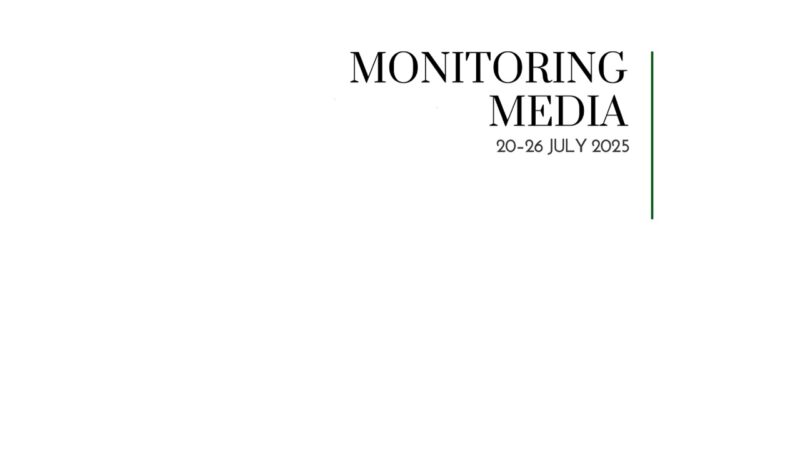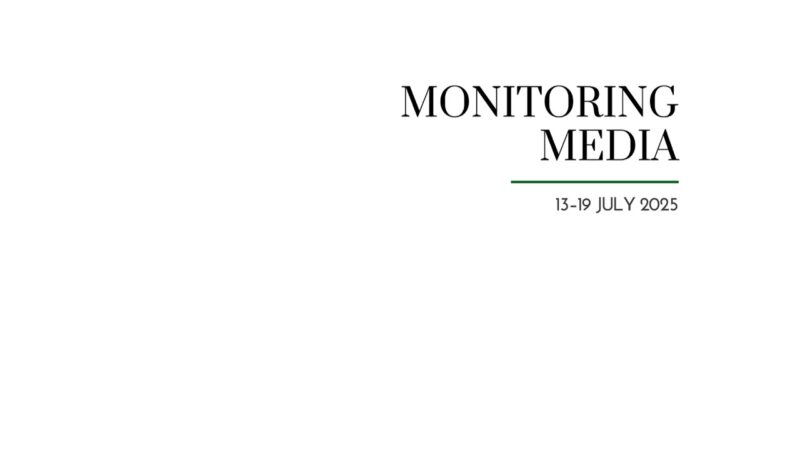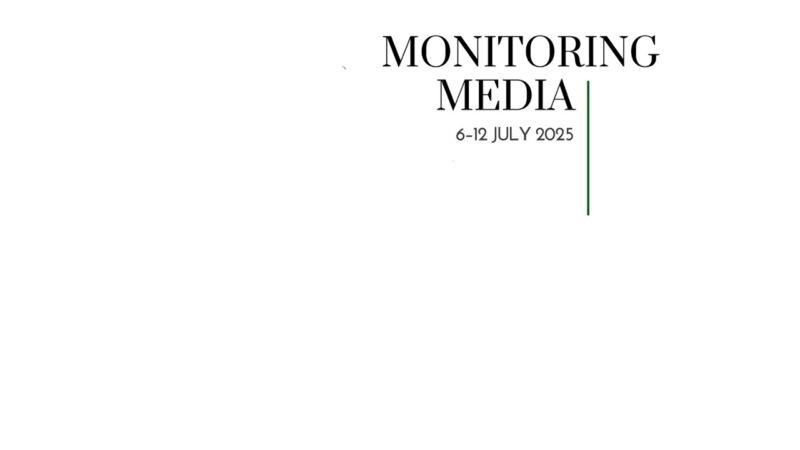US will arm Ukraine with cluster munitions

CIUS weekly report on North American media coverage of Ukrainian affairs, 2–7 July 2023
Two publications (The Conversation and Politico) were selected to prepare this report on how the situation in Ukraine has been portrayed in the North American press during the past week (2–7 July 2023). The sample was compiled based on their impact on public opinion as well as on their professional reputation, popularity among the readership, and topical relevance. These two publications represent centrist viewpoints on the political spectrum.
This report covers only the most-read and relevant articles about Ukraine, as ranked by the respective North American publications themselves in the past week. Its scope covers promoted articles on home pages and articles from special sections on Ukraine, with the hashtag #Ukraine, from the paper editions of the publications, and about Ukraine from opinion columns and editorials.
Topics featured in the selected articles:
- Ukraine’s current affairs: destruction of the Kakhovka Dam is a multi-layered catastrophe for years to come; Ukraine’s scientists and institutions require support from international partners;
- The world and Ukraine: US will provide Ukraine with cluster munitions; Canada designs legal mechanisms to transfer frozen Russian assets to Ukraine; NATO summit in Vilnius expected to make the alliance more vibrant and anticipated to unlock new paths of cooperation with Ukraine;
- Russia at war: Prigozhin’s mutiny became a shock for Putin’s regime but not an unbearable one.
Main arguments:
Destruction of the Kakhovka Dam caused economic, agricultural, and ecological devastation for years to come. Susanne Wengle and Vitalii Dankevych (The Conversation) list dozens of changes that have already occurred and are likely to occur in Ukraine and abroad following the destruction of the Kakhovka Dam, the last of the cascade of six reservoir fortifications along the Dnipro River on its way to the Black Sea. First, as an immediate consequence, the city of Kherson was flooded and threats emerged to the cooling system of the Zaporizhia Nuclear Power Plant. Secondly, the agricultural output of Ukraine’s southeast regions is set to decrease: “Roads, train tracks, and irrigation canals were washed away. Crops in fields and orchards in the Kherson and Zaporizhzhia regions were inundated, then left to shrivel after the water drained. Crimea, once a region known for its sunny beaches and rice fields, could dry up without irrigation.” Thirdly, the climate of southern Ukraine will likely become more desert-like—farmlands that are no longer irrigated and cultivated will dry up and become more vulnerable to soil erosion and dust storms. Fourthly, “this year’s crops in the flooded zone will be waterlogged, and much of the harvest will be destroyed. Rich and productive topsoil may be washed away.” Fifthly, many river basins downstream from the Kakhovka Dam are now polluted, because of around 150 tons of oil that leaked out during the explosion and at least 17 gas stations that were flooded. Wengle and Dankevych raise concerns that people in southern Ukraine may soon face problems accessing drinking water. The region’s wildlife, including many types of nesting and migratory birds, will also be considerably harmed. Finally, because the agricultural output will be reduced for years to come, expected disruptions in global supply chains will affect food security around the world, especially in the countries of Africa. These and other detrimental developments lead the authors to conclude that future droughts “will virtually destroy rural life in southeastern Ukraine as it existed before June 6.”
Ukrainian science sector is in dire need of international recognition and support. Ina Ganguli, Michael E. Rose, Oleksandra Ivashchenko, and Stefano Horst Baruffaldi (The Conversation) examine the detrimental effect that the war has brought to Ukrainian science, outline possible ways to endure the current challenges, and offer solutions to bring the sector back on track once the fighting is over: “Damage to a country’s science system—like what is happening in Ukraine—can harm economic growth for decades. However, research shows that local and international policymakers can minimize this harm by providing direct funding to researchers, creating remote research positions and offering research opportunities abroad to Ukrainian scientists.” The authors highlight that since 24 February 2022, 22 percent of research and higher education institutions have been physically damaged, which “includes five of the country’s top 20 institutions and 20 of the top 100.” Also, 10 percent of Ukraine’s roughly 60,000 scientists (predominantly women), have fled the country since the start of the invasion. On top of that, the Ukrainian government has announced a 20 percent decrease in funding for academic scholarships and national research grants, which partially contributed to a 10 percent decrease in published articles in 2022 compared to 2021. The mentioned destruction and brain drain pose a threat to sustained economic growth, for which university research is a catalyst. To mitigate the detrimental effects on Ukrainian science, the authors encourage the international academic community to implement three solutions: provide monetary support which could replace the lost domestic funding; offer remote research positions to scientists who remained in Ukraine; provide resident research opportunities to Ukrainian scientists abroad.
US to provide Ukraine with cluster munitions in the near future. Alexander Ward, Lara Seligman, Joe Gould and Paul McLeary (Politico) analyze the debate in US political circles about arming Ukraine with controversial cluster munitions. On 7 July the Biden administration announced that it would deliver a new weapons package totalling around US$800 million to support Ukraine’s war effort. The package would include “dozens” of Bradley and Stryker fighting vehicles, air defence missiles, anti-mine equipment, as well as cluster munitions. According to the authors, “Ukrainian forces are struggling to break through Russia’s front lines during their counteroffensive, and officials believe that providing the [cluster] munitions—which Russians have already used and which litter the battlefield—will give Kyiv an edge as its supplies of conventional weapons dwindle.” The controversy regarding cluster munitions resides in their potential to inflict high levels of unintended harm on people: “They are designed to take out multiple military targets by scattering large numbers of explosive ‘bomblets’ over a wide area, but the unexploded [‘dud’] ordnance left behind can pose danger to civilians both during the conflict and for years afterward.” For that reason, cluster munitions have been banned by more than 100 countries. In the US, several key Republicans have been urging the president for months to provide the controversial munitions to Ukraine. At the same time, a few influential figures in Biden’s own party were either skeptical or openly criticized such a move. To this, the authors add that the most recent Human Rights Watch report argues that like Russia, Ukraine also has a record of recently using cluster munitions, in particular during the liberation of the town of Izium; Ukraine denies these accusations.
In another article, Lawrence Ukenye (Politico) adds that regardless of the threat coming from cluster munitions, Biden’s administration notes that “there is also a massive risk of civilian harm if Russian troops and tanks roll over Ukrainian positions and take more Ukrainian territory and subjugate more Ukrainian civilians because Ukraine does not have enough artillery.” In turn, the Pentagon declared that “the US will be providing Ukraine with its most modern cluster munitions, with dud rates of less than 2.35 percent, meaning the bombs are less likely to fail when deployed. The Pentagon also received written assurances from Kyiv that the bombs would not be used in urban areas populated by civilians.” Another argument in favour of providing Ukraine with cluster munitions is that Russia has already been intensively using them on the battlefield. Thus, after the war is over all places of active fighting are going to be demined anyway.
Canada is working on mechanisms to redirect frozen Russian state assets toward rebuilding Ukraine. Robert J. Currie (The Conversation) writes that Canada was the first country to introduce measures that allow the seizing of Russian assets on its territory and using them—or the money made from selling them—to help Ukrainian war relief. However, these Canadian measures are only applicable to Russian individuals and businesses, not the state and its assets. Under international law, “states are generally immune from court proceedings in other countries. Their property is protected from seizure or execution, especially assets owned or held by central banks.” The state assets are where the majority of Russian money resides. To bypass this obstacle, the government of Canada should find alternative measures within the framework of international law and upgrade its corresponding legislation. Currie argues that “on the international law side…repurposing Russia’s state assets would be lawful under a system of what we call ‘Multilateral Asset Transfer,’ using the doctrine of ‘countermeasures.’” This means that in light of Russia’s breach of the principle of inviolability of a sovereign border, Ukraine is allowed to counter the state-aggressor, apply reciprocal measures, and “break some other legal obligation owed to the breaching country.” Such measures may entail redirecting Russian state assets to Ukraine’s needs. On the domestic level, the federal government can declare that Canada is imposing countermeasures by suspending the immunity assigned to Russia’s state assets. Afterwards, the government should create an escrow account—call it, say, a “Ukraine Trust Fund”—and order Canadian financial institutions to surrender Russian assets to it. Another route would be to declare Russia a terrorist state under the Justice for Victims of Terrorism Act, which would end its immunity and make its sovereign assets open to seizure.
NATO will be more resilient following the Vilnius summit, but Ukraine will probably not get an invitation. Mark Webber (The Conversation) outlines tasks and challenges ahead of the NATO summit in Vilnius on 11 July, as well as speculates about possible outcomes. At the start of his article Webber states that “Russia’s invasion of Ukraine has certainly given NATO a fresh sense of purpose and momentum.” The alliance came back to its roots, which entail providing a collective defence for Europe. Therefore, at the Vilnius summit the leaders of member-states are expected to approve a set of regional European plans—NATO’s most detailed defence documents since the end of the Cold War. Alongside that, the European states will discuss synergizing their significantly increased defence budgets: “In 2022, defence spending in Central and Western Europe was at its highest level in real terms since 1989.” Webber also writes that solid guarantees of Ukraine’s future membership in NATO will be hard to get in Vilnius: “No one in NATO is arguing in favour of granting membership while Ukraine remains at war.” Unlike the loyally supportive Poland and the Baltic republics, the US and Germany have concerns that inviting Ukraine to NATO today will only prolong the war. Therefore, instead of becoming a subject of the alliance’s collective defence, the most likely outcome for Ukraine will be enhanced direct collaboration with individual NATO members. Webber concludes that apart from debating the case of Ukraine, the leaders of the alliance will also address the replacement of Jens Stoltenberg as Secretary General (no successor has been found yet), acceptance of Sweden as a full member, and countering Chinese expansion into the Asia-Pacific region.
NATO members’ security directly depends on Ukraine’s participation and the elimination of “gray zones” in Europe. An open letter published in Politico, signed by 46 foreign policy experts, advocates that Ukraine should be provided with a NATO membership roadmap at the summit in Vilnius on 11 July. This is particularly important because Putin’s expansionist ambitions have remained unaddressed to date and, therefore, “leaving Ukraine in a gray zone of ambiguity invites [further] Russian aggression.” The experts argue that NATO members should ensure that “Ukraine (1) wins this war and reestablishes full control over its internationally recognized 1991 borders; and (2) is fully anchored in the security and economic arrangements that from 1945 until 2014 made Europe a continent of peace, prosperity and cooperation. The transatlantic community can only be stable and secure if Ukraine is secure.” To achieve this, both Ukraine and NATO members at the forthcoming summit should establish a deterrence and defence partnership. This partnership should receive an uninterrupted supply of weapons to Ukraine, as well as accelerate the country’s integration into transatlantic security structures. Apart from that, at the Vilnius summit “the allies and Ukraine should upgrade the NATO-Ukraine Commission to a NATO-Ukraine Council,” which would allow for a faster response of the alliance to Ukraine’s needs. Another objective entails in launching “a joint process of developing a Ukrainian long-term national security strategy, national defence strategy, and national defence posture compatible with NATO standards and planning.” In a word, the experts advocate that Ukraine should be helped to reach the NATO standards as soon as possible, sustainably supported in its war effort, and unequivocally invited to join the alliance.
Prigozhin’s mutiny posed a threat to Putin’s rule and Russia’s integrity. The Conversation team interviews Gregory F. Treverton, a former chairman of the National Intelligence Council in the Obama administration, about the reasons and outcomes of Wagner’s mutiny in Russia. In his answers, Treverton highlights a few pivotal points. First, by authorizing the mutiny Prigozhin took a huge risk and very likely “overstepped the line.” From Putin’s perspective, such arrogance needs to be disciplined, including through assassination. That being said, the mutiny has brought many other repercussions and continues to unfold. Secondly, the US attitude toward Putin has evolved—from cautiously cooperative in the 1990s, when he was involved in denuclearizing former Soviet republics, to distrustful in the mid-2000s, when he declared his enmity toward NATO. Overall, Putin has always been isolated from Russian domestic and international political life and spoke only to selected advisors whom he had helped to ascend to power. Thirdly, for the past twenty years Putin has constructed a hierarchy of absolute governance and failed to modernize the national economy. That has turned out to be a major challenge for the US. Thirdly, “having Putin remain in power through this Prigozhin affair was probably better than the chaos that might have ensued if Putin had been ousted.” However, “in the long run, the US seems to have moved to a position on the Ukraine war where we basically say…Putin has to go.” Fourthly, Putin would likely never agree to sign for peace with Ukraine. Therefore, if Prigozhin had succeeded, this could have opened more room for negotiations. At the same time, Prigozin’s success and following rearrangements in the Kremlin risked provoking a clash of warlords in Russia: “The US would like Putin and Russia to behave better. On the other hand, we don’t want Russia to become a kind of lawless space to the east of Europe with nuclear weapons.” Treverton’s concluding thought is that “the war is going to be bad for Russia, no matter how it ends.”
Eugene Rumer (Politico) also provides an interpretation of Prigozhin’s mutiny and concludes that it was neither successful nor had any major impact on Putin’s regime. Surely the Russian leader was unpleasantly surprised by the development, but there is no evidence that he lost his grip over the security services, army command, or regional leaders. Prigozhin’s insults of Defense Minister Sergei Shoigu and Chief of the General Staff Valery Gerasimov were too much to bear for his sympathizers among the Russian establishment and security chiefs: “He gambled and lost. The regime held steady and remained loyal to Putin. If anything, it is more secure now.” Moreover, following the mutiny Prigozhin’s popularity among Russians plummeted from 58 percent to 34 percent, while Putin’s approval rating remained unchanged at 82 percent. There are also no signs of Russia broadly fracturing, because the provincial governors have been cherry-picked by Putin and remain loyal to him.
